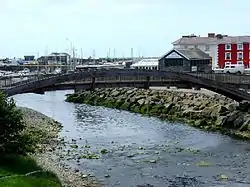River Aeron
The River Aeron (Welsh: Afon Aeron) is a small river in Ceredigion, Wales, that flows into Cardigan Bay at Aberaeron. It is also referred to on some older maps as the River Ayron. Pughe's Dictionary of the Welsh Language states that Aeron in Welsh meant: "queen of brightness".[1]
| River Aeron | |
|---|---|
 The Aeron at Aberaeron | |
| Native name | Afon Aeron |
| Location | |
| Country | Wales |
| Physical characteristics | |
| Source | Llyn Eiddwen |
| • coordinates | 52°16′58.8″N 4°2′38.4″W |
| Mouth | Aberaeron |
• coordinates | 52°14′36.52″N 4°15′52.24″W |
Sources
It has its source in Llyn Eiddwen, in the range of hills called Mynydd Bach. It then follows a more or less westerly and then north-westerly track to the sea. It has a rather broad river valley bounded by low hills and has relatively few significant tributaries which include the Gwenffrwd, Nant Wysg, Nant Picadilly, Nant y Wernen and Nant Rhiw Afallan. The Afon Mydr drains an area of old woodlands and dairy farming and includes the old farm of Rhiwbren Fawr.
On its way to the sea, the Aeron passes through Felinfach and by the village of Ciliau Aeron. It passes close to the restored mansion at Llanerchaeron which is now in the care of the National Trust before entering the town of Aberaeron where it passes into Cardigan Bay.
Despite the relatively small size of the river, it sustains a population of salmon and brown trout.
Literary tradition
Dylan Thomas lived near the banks of the river in the 1940s, at a secluded mansion called Plas Gelli, just outside Talsarn. He called the Aeron valley "the most precious place in the world." The Dylan Thomas Trail follows the river from Talsarn to Aberaeron.
Talsarn was the centre for a thriving group of poets who lived in and around the Aeron valley, such as John Jenkins (Cerngoch),[2] Dan Jenkins Pentrefelin (1856-1946)[3] and Dinah Davies (1851-1931). There are still poets in the valley today, including Ciliau Aeron poet, Stevie Krayer, who has written a sequence of poems about the river.[4]
Although the Aeron has suffered from intermittent pollution including some severe incidents in the 1970s caused by creamery waste and crude sewage escapes in the Felinfach area, the principal impacts are now diffuse agricultural waste, pesticides from agriculture and acidification especially from upland forestry plantations.
References
- William Owen Pughe, A Dictionary of the Welsh Language: Explained in English, Volume 1, 1803, page 23.
- Jenkins D. and Lewis D. Cerddi Cerngoch Caxton Hall, Lampeter, 1904
- Leech, Alan. Dan Jenkins: a biography. Y Lolfa Talybont 2007
- Krayer, Stevie. Questioning the Comet. Gomer 2004.

